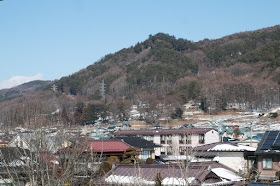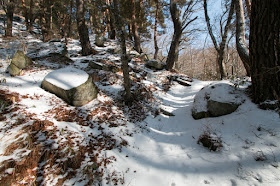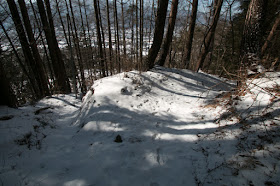Uehara Castle
-Castle looked at rise and fall of Takeda clan-
Overhead
Name: Uehara castle (Uehara-jo)
Alias:
Place: Chino Chino city, Nagano
Location: 36.00905324830773, 138.14833423852053
Type: Mountain Castle
Built: 16th century
Remnants: Clay walls and dry moats
Title:
Uehara castle (上原城) is located at Konpirayama mountain, a ridge of 150 meter height from hillside spreads from Eimeijiyama mountain in the west part of Chino city. The castle sight is a bottle neck point at the eastern edge of Suwa basin, which is a elliptical shaped on at the south middle part of Shinano province (Nagano prefecture).
Suwa basin is an important crossing point of roads from Ina valley at southwest, Shiojiri and Matsumoto area at northwest, Komoro and Ueda area at northeast, and Kai province (Yamanashi prefecture) through Kobuchizawa area at southeast. Site of Uehara castle is applicable to the eastern gate of Suwa basin, and also a merging point of mountainous road from Takato area.
Precise year is unknown but Uehara castle was originally built as a main base of local lord Suwa clan. Originally Suwa clan had been a house of the priest of Suwa Taisha shrine, a traditional one traced to ancient era. Suwa Taisha shrine had been worshiped as god of war by many samurais, including Hojyo clan which was the house of chancellor of Kamakura Shogunate.
As the shrine had large donated manor and was involved in many conflicts because of the relationship with Hojyo clan, gradually Suwa clan formed local retainers and transformed into the local lord. In Muromachi era, Muromachi Shogunate sent Ogasawara clan as the governor of Shinano province, and Suwa clan once became the retainer of Ogasawara clan. But Ogasawara clan declined because of their internal conflicts and their authority became limited to current Matsumoto basin, thus Suwa clan became a warlord of Suwa basin even though a small one and reigned the basin by their strength.
At the period of Yorimitsu Suwa (1473-1540), Suwa clan became its peak period. Originally Suwa clan had a unstable structure because of the conflict of Suwa clan, the house of upper shrine and Kanasashi clan at lower shrine, and also a dual authority system of religious leader and political leader.
Yorimitsu who was lost his father by rebellion defeated Kanasashi clan and united Suwa basin, then next fought with Nobutora Takeda (1494-1574), the warlord of Kai province and the father of famous Shingen Takeda (1521-1573) and beat it. Yorimitsu made alliance with Takeda clan and let his grandson Yorishige Suwa (1516-1542) with the daughter of Nobutora, then attacked surrounding areas such as Saku area or Takato area.
After the death of Yorimitsu, Yorishige succeeded the leader but many hidden troubles emerged. Conflict with Kanasashi clan started again, and continuous campaign by Yorimitsu and severe crop failure raised dissatisfaction of people. Furthermore, in 1541, Nobutora was expelled by his son Shingen Takeda. Shingen stabilized relationship with Hojyo clan at backside and aimed at fully expansion toward Shinano province. As an entrance to Shinano province, Suwa basin became the first target of Shingen.
In 1542, Shingen seduced rebellion of Kanasashi clan or Takato clan against Yorishige then invaded into Suwa basin with dominant army. Yorishige was off guard because of alliance with Takeda clan could not intercept at border and besieged at Uehara castle, but could not stand and escaped to Kuwabara castle at 5 kilometer west from Uehara castle. But most soldiers of Yorishige gave up and left, then Yorishige surrendered to Shingen believing the promise to save him.
But Shingen broke the promise and forced Yorishige to kill himself. Shingen at first divided Suwa basin between Takeda clan and Takato clan, but later Takato clan rebelled to Shingen and once captured Uehara castle. But Shingen waited this situation ruined Takato clan, thus Takeda clan captured whole part of Suwa basin. Shingen renovated Uehara castle as a bridgehead into Shinano province, and placed his important retainer Nobukata Itagaki (1489-1548).
Uehara castle roughly consist of hilltop fortress and halfway residence. Hilltop area is formed by a central area of 20 meter long triangle shaped area at the top of the mountain. Below of this central area, two layer of corridor area surrounded whole part of the peak, along with attached small terraces.
The eastern slope is the weak point of the castle connecting to backside Eimeijiyama mountain, thus this direction is protected by huge complex of two dry moats of over 20 meter wide. Many natural rocks lies scattered over hilltop area, which might show the religious authority of Suwa clan. Especially there was a huge stone of over 5 meter tall at the entrance of hilltop area, which has a name of watchtower stone.
At the halfway of the mountain, a large flat area of 100 meter long and 50 meter wide is built. This area has a name of Itagakidaira, and might be used as a residence of Nobukata Itagaki. At hillside a there is a large flat space currently used as a ground of Raigakuji temple, and considering small size of the castle considering role of Nobukata, there might be outer area used as a residence of soldiers.
Based on Uehara castle, Shingen continuously intruded into Shinano province. By 1545 Shingen captured Ina area at the south edge of Shinano prefecture and faced strong power of north part such as Ogasawara clan and Murakami clan. Among such situation, considering as a function of local administration base or supply base Uehara castle was too narrow and inconvenient, thus Shingen newly built Takashima castle at the side of Lake Suwako. But Uehara castle itself was kept as a military base.
Over 20 years Takeda clan continued expansion and regarded as one of the strongest lord in Japan, but after the death of Shingen in 1573, the clan turned to decline before the growth of central ruler Nobunaga Oda (1534-1582). Katsuyori Takeda (1546-1582), the successor of Shingen and son of the daughter of former Suwa clan, desperately countered against Nobunaga but suffered severe defeat at the battle of Nagashino in 1575.
In 1582, looking at the leave of Kiso clan which was the lord of Kiso valley from Takeda clan, Nobunaga sent a dominant army toward Takeda territory from many directions. Hearing this news, in February, Katsuyori lead his army and stayed at Uehara castle, to subjugate Kiso clan and prepare for the invasion of Oda main army at his ground.
But Nobukimi Ayanama (1541-1582), a close relative and important retainer of Katsuyori, betrayed Katsuyori at backside and marched to Kofu city which was the capital of Takeda clan, thus Katsuyori gave up the resistance at Uehara castle and retreated to his main base Shinpu castle (Yamanashi prefecture). As a result, Takeda clan too easily collapsed then Katsuyori died just after one month at the hillside of Tenmokusan mountain. Uehara castle just looked at the rise and fall of Takeda clan was abolished then.
Now all building was lost but structure of the castles such as clay wall or dry moat well remain on the hill. From castle site full scenery of east half of Suwa basin is seen, and it shows the importance of the castle both as a residence of Suwa clan and strategic base of Takeda clan. It is also imagined the despair of Yorishige Suwa and Katsuyori Takeda who had to face dominant army with this small castle.
Takashima Castle -Floating castle on Lake Suwa-
Shinpu Castle -Castle built by tragic brave successor of Shingen-
Type: Mountain Castle
Built: 16th century
Remnants: Clay walls and dry moats
Title:
Brief History
Uehara castle (上原城) is located at Konpirayama mountain, a ridge of 150 meter height from hillside spreads from Eimeijiyama mountain in the west part of Chino city. The castle sight is a bottle neck point at the eastern edge of Suwa basin, which is a elliptical shaped on at the south middle part of Shinano province (Nagano prefecture).
Suwa basin is an important crossing point of roads from Ina valley at southwest, Shiojiri and Matsumoto area at northwest, Komoro and Ueda area at northeast, and Kai province (Yamanashi prefecture) through Kobuchizawa area at southeast. Site of Uehara castle is applicable to the eastern gate of Suwa basin, and also a merging point of mountainous road from Takato area.
Main base of priest clan
Precise year is unknown but Uehara castle was originally built as a main base of local lord Suwa clan. Originally Suwa clan had been a house of the priest of Suwa Taisha shrine, a traditional one traced to ancient era. Suwa Taisha shrine had been worshiped as god of war by many samurais, including Hojyo clan which was the house of chancellor of Kamakura Shogunate.
As the shrine had large donated manor and was involved in many conflicts because of the relationship with Hojyo clan, gradually Suwa clan formed local retainers and transformed into the local lord. In Muromachi era, Muromachi Shogunate sent Ogasawara clan as the governor of Shinano province, and Suwa clan once became the retainer of Ogasawara clan. But Ogasawara clan declined because of their internal conflicts and their authority became limited to current Matsumoto basin, thus Suwa clan became a warlord of Suwa basin even though a small one and reigned the basin by their strength.
At the period of Yorimitsu Suwa (1473-1540), Suwa clan became its peak period. Originally Suwa clan had a unstable structure because of the conflict of Suwa clan, the house of upper shrine and Kanasashi clan at lower shrine, and also a dual authority system of religious leader and political leader.
Yorimitsu who was lost his father by rebellion defeated Kanasashi clan and united Suwa basin, then next fought with Nobutora Takeda (1494-1574), the warlord of Kai province and the father of famous Shingen Takeda (1521-1573) and beat it. Yorimitsu made alliance with Takeda clan and let his grandson Yorishige Suwa (1516-1542) with the daughter of Nobutora, then attacked surrounding areas such as Saku area or Takato area.
Fall of Suwa clan and Uehara castle
After the death of Yorimitsu, Yorishige succeeded the leader but many hidden troubles emerged. Conflict with Kanasashi clan started again, and continuous campaign by Yorimitsu and severe crop failure raised dissatisfaction of people. Furthermore, in 1541, Nobutora was expelled by his son Shingen Takeda. Shingen stabilized relationship with Hojyo clan at backside and aimed at fully expansion toward Shinano province. As an entrance to Shinano province, Suwa basin became the first target of Shingen.
In 1542, Shingen seduced rebellion of Kanasashi clan or Takato clan against Yorishige then invaded into Suwa basin with dominant army. Yorishige was off guard because of alliance with Takeda clan could not intercept at border and besieged at Uehara castle, but could not stand and escaped to Kuwabara castle at 5 kilometer west from Uehara castle. But most soldiers of Yorishige gave up and left, then Yorishige surrendered to Shingen believing the promise to save him.
But Shingen broke the promise and forced Yorishige to kill himself. Shingen at first divided Suwa basin between Takeda clan and Takato clan, but later Takato clan rebelled to Shingen and once captured Uehara castle. But Shingen waited this situation ruined Takato clan, thus Takeda clan captured whole part of Suwa basin. Shingen renovated Uehara castle as a bridgehead into Shinano province, and placed his important retainer Nobukata Itagaki (1489-1548).
Structure of Uehara castle
Uehara castle roughly consist of hilltop fortress and halfway residence. Hilltop area is formed by a central area of 20 meter long triangle shaped area at the top of the mountain. Below of this central area, two layer of corridor area surrounded whole part of the peak, along with attached small terraces.
The eastern slope is the weak point of the castle connecting to backside Eimeijiyama mountain, thus this direction is protected by huge complex of two dry moats of over 20 meter wide. Many natural rocks lies scattered over hilltop area, which might show the religious authority of Suwa clan. Especially there was a huge stone of over 5 meter tall at the entrance of hilltop area, which has a name of watchtower stone.
At the halfway of the mountain, a large flat area of 100 meter long and 50 meter wide is built. This area has a name of Itagakidaira, and might be used as a residence of Nobukata Itagaki. At hillside a there is a large flat space currently used as a ground of Raigakuji temple, and considering small size of the castle considering role of Nobukata, there might be outer area used as a residence of soldiers.
Bridgehead of Takeda clan
Based on Uehara castle, Shingen continuously intruded into Shinano province. By 1545 Shingen captured Ina area at the south edge of Shinano prefecture and faced strong power of north part such as Ogasawara clan and Murakami clan. Among such situation, considering as a function of local administration base or supply base Uehara castle was too narrow and inconvenient, thus Shingen newly built Takashima castle at the side of Lake Suwako. But Uehara castle itself was kept as a military base.
Over 20 years Takeda clan continued expansion and regarded as one of the strongest lord in Japan, but after the death of Shingen in 1573, the clan turned to decline before the growth of central ruler Nobunaga Oda (1534-1582). Katsuyori Takeda (1546-1582), the successor of Shingen and son of the daughter of former Suwa clan, desperately countered against Nobunaga but suffered severe defeat at the battle of Nagashino in 1575.
In 1582, looking at the leave of Kiso clan which was the lord of Kiso valley from Takeda clan, Nobunaga sent a dominant army toward Takeda territory from many directions. Hearing this news, in February, Katsuyori lead his army and stayed at Uehara castle, to subjugate Kiso clan and prepare for the invasion of Oda main army at his ground.
But Nobukimi Ayanama (1541-1582), a close relative and important retainer of Katsuyori, betrayed Katsuyori at backside and marched to Kofu city which was the capital of Takeda clan, thus Katsuyori gave up the resistance at Uehara castle and retreated to his main base Shinpu castle (Yamanashi prefecture). As a result, Takeda clan too easily collapsed then Katsuyori died just after one month at the hillside of Tenmokusan mountain. Uehara castle just looked at the rise and fall of Takeda clan was abolished then.
Afterward of castle
Now all building was lost but structure of the castles such as clay wall or dry moat well remain on the hill. From castle site full scenery of east half of Suwa basin is seen, and it shows the importance of the castle both as a residence of Suwa clan and strategic base of Takeda clan. It is also imagined the despair of Yorishige Suwa and Katsuyori Takeda who had to face dominant army with this small castle.
Related Castles
Takashima Castle -Floating castle on Lake Suwa-
Shinpu Castle -Castle built by tragic brave successor of Shingen-






































































No comments:
Post a Comment